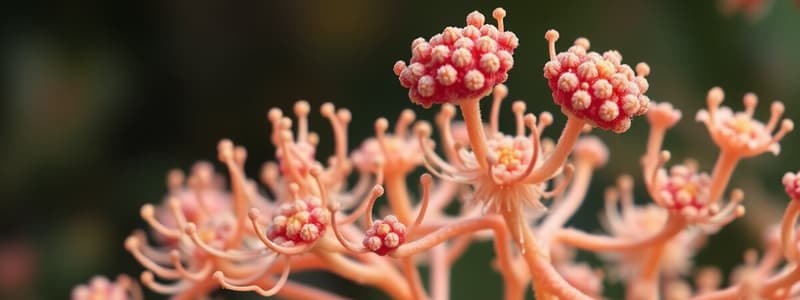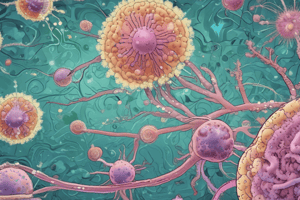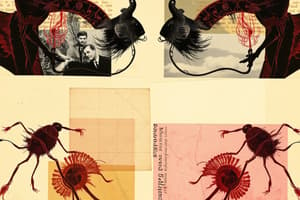Podcast
Questions and Answers
What is the main method of multiplication for Chlamydiaceae?
What is the main method of multiplication for Chlamydiaceae?
- Budding
- Conjugation
- Mitosis
- Binary fission (correct)
Which of the following diseases is caused by Rickettsiaceae rickettsii?
Which of the following diseases is caused by Rickettsiaceae rickettsii?
- Epidemic typhus
- Lyme disease
- Rocky Mountain spotted fever (correct)
- Endemic typhus
What unique observation is used to diagnose Anaplasmataceae infections?
What unique observation is used to diagnose Anaplasmataceae infections?
- PCR amplification of 16S rRNA
- Presence of endospore formation
- Identification of morulae in leukocytes (correct)
- Visualizing motility through flagella
What is the primary vector for transmitting Coxiella burnetii?
What is the primary vector for transmitting Coxiella burnetii?
Which of the following diseases is characterized by a 'bull's-eye' rash during its early stage?
Which of the following diseases is characterized by a 'bull's-eye' rash during its early stage?
Which organism is responsible for causing pelvic inflammatory disease (PID)?
Which organism is responsible for causing pelvic inflammatory disease (PID)?
What stage of syphilis is characterized by the presence of a chancre?
What stage of syphilis is characterized by the presence of a chancre?
Which species causes relapsing fever?
Which species causes relapsing fever?
What is the main transmission route for Ehrlichia chaffeensis?
What is the main transmission route for Ehrlichia chaffeensis?
What distinguishes Mycoplasma pneumoniae from other bacterial families?
What distinguishes Mycoplasma pneumoniae from other bacterial families?
What is the primary role of the reticulate body in the Chlamydiaceae family?
What is the primary role of the reticulate body in the Chlamydiaceae family?
Which of the following routes is NOT associated with the transmission of Coxiella burnetii?
Which of the following routes is NOT associated with the transmission of Coxiella burnetii?
What characterizes the Gram-negative-like cell wall structure of Chlamydiaceae and Rickettsiaceae?
What characterizes the Gram-negative-like cell wall structure of Chlamydiaceae and Rickettsiaceae?
What is the incubation period for Rickettsiaceae infections after transmission through vector bites?
What is the incubation period for Rickettsiaceae infections after transmission through vector bites?
Which disease is associated with Leptospira interrogans and can lead to severe complications?
Which disease is associated with Leptospira interrogans and can lead to severe complications?
In the context of spirochetes, which organism is known for primarily being transmitted through sexual contact or transplacental?
In the context of spirochetes, which organism is known for primarily being transmitted through sexual contact or transplacental?
What observation is crucial for diagnosing infections from the Anaplasmataceae family?
What observation is crucial for diagnosing infections from the Anaplasmataceae family?
Which feature distinguishes Mycoplasma pneumoniae from other bacterial organisms?
Which feature distinguishes Mycoplasma pneumoniae from other bacterial organisms?
What is the vector for Anaplasma phagocytophilum, the causative agent of human granulocytic anaplasmosis?
What is the vector for Anaplasma phagocytophilum, the causative agent of human granulocytic anaplasmosis?
Flashcards
Chlamydiaceae Family
Chlamydiaceae Family
Obligate intracellular bacteria, gram-negative-like cell wall, containing DNA, RNA, and ribosomes, multiplying through binary fission.
Elementary Body
Elementary Body
Infectious form of Chlamydia
Reticulate Body
Reticulate Body
Metabolically active, non-infectious form of Chlamydia
Chlamydia trachomatis
Chlamydia trachomatis
Signup and view all the flashcards
Rickettsiaceae Family
Rickettsiaceae Family
Signup and view all the flashcards
Rocky Mountain Spotted Fever
Rocky Mountain Spotted Fever
Signup and view all the flashcards
Epidemic Typhus
Epidemic Typhus
Signup and view all the flashcards
Anaplasmataceae Family
Anaplasmataceae Family
Signup and view all the flashcards
Coxiella
Coxiella
Signup and view all the flashcards
Mycoplasmataceae Family
Mycoplasmataceae Family
Signup and view all the flashcards
Spirochetes
Spirochetes
Signup and view all the flashcards
Lyme Disease
Lyme Disease
Signup and view all the flashcards
Syphilis
Syphilis
Signup and view all the flashcards
Leptospirosis
Leptospirosis
Signup and view all the flashcards
Chlamydiaceae Family
Chlamydiaceae Family
Signup and view all the flashcards
Elementary Body
Elementary Body
Signup and view all the flashcards
Reticulate Body
Reticulate Body
Signup and view all the flashcards
Trachoma
Trachoma
Signup and view all the flashcards
LGV
LGV
Signup and view all the flashcards
Rickettsiaceae Family
Rickettsiaceae Family
Signup and view all the flashcards
Rocky Mountain Spotted Fever
Rocky Mountain Spotted Fever
Signup and view all the flashcards
Epidemic Typhus
Epidemic Typhus
Signup and view all the flashcards
Anaplasmataceae Family
Anaplasmataceae Family
Signup and view all the flashcards
Coxiella burnetii
Coxiella burnetii
Signup and view all the flashcards
Mycoplasmataceae Family
Mycoplasmataceae Family
Signup and view all the flashcards
Walking Pneumonia
Walking Pneumonia
Signup and view all the flashcards
Spirochetes
Spirochetes
Signup and view all the flashcards
Lyme Disease
Lyme Disease
Signup and view all the flashcards
Syphilis
Syphilis
Signup and view all the flashcards
Leptospirosis
Leptospirosis
Signup and view all the flashcards
Study Notes
Chlamydiaceae Family
- Obligate intracellular parasites, possessing a gram-negative-like cell wall.
- Contains DNA, RNA, and ribosomes; relies on host ATP for energy.
- Multiplies via binary fission.
- Two forms: Elementary body (infectious) and Reticulate body (metabolically active, non-infectious).
- Chlamydia trachomatis: Infects epithelial cells in mucous membranes, causing:
- Trachoma: Leading cause of preventable blindness.
- Lymphogranuloma Venereum (LGV): Sexually transmitted infection (STD) prevalent in tropical regions.
Rickettsiaceae Family
- Obligate intracellular parasites transmitted by arthropod vectors (ticks, lice).
- Incubation period: 3-14 days.
- Multiplies within endothelial cells.
- Common symptoms: Rash, fever.
- Rickettsia rickettsii: Causes Rocky Mountain spotted fever, vectored by ticks.
- Rickettsia prowazekii: Causes epidemic typhus, transmitted by human body lice.
- Rickettsia typhi: Causes endemic typhus, vectored by fleas.
Anaplasmataceae Family
- Diagnosed through observation of morulae (bacterial clusters) within leukocytes.
- Ehrlichia chaffeensis: Causes human monocytic ehrlichiosis, transmitted by the lone star tick.
- Anaplasma phagocytophilum: Causes human granulocytic anaplasmosis.
Coxiella
- Diagnosis often uses immunofluorescence.
- Requires Biosafety Level 3 laboratory containment.
- Coxiella burnetii: Causes Q fever, transmitted through aerosols, ticks, and can survive outside hosts.
Mycoplasmataceae Family
- Small bacteria lacking a cell wall.
- Mycoplasma pneumoniae: Causes tracheobronchitis (walking pneumonia).
- Mycoplasma hominis: Causes pelvic inflammatory disease (PID) and postpartum fever.
- Mycoplasma genitalium/urealyticum: Causes nongonococcal urethritis (NGU).
Spirochetes
- Helically coiled, motile bacteria with gram-negative-like walls.
- Motility facilitated by periplasmic flagella.
- Borrelia burgdorferi: Causes Lyme disease, carried by deer ticks.
- Early stage: Erythema migrans rash.
- Disseminated stage: Bacteria spreads to CNS and heart.
- Chronic stage: Potential arthritis.
- Other Borrelia species: Cause relapsing fever.
- Treponema pallidum: Causes syphilis, transmitted through sexual contact or transplacental.
- Stages: Primary (chancre), Secondary (rash), Tertiary (gummas).
- Subspecies:
- T. pallidum pertenue: Causes yaws from direct contact.
- T. pallidum bejel: Non-sexually transmitted syphilis.
- T. pallidum carateum: Causes a papule with a red halo.
- Leptospira interrogans: Causes leptospirosis, transmitted through contact with animal urine, infected soil/water, a severe form called Weil's disease.
Studying That Suits You
Use AI to generate personalized quizzes and flashcards to suit your learning preferences.
Description
Test your knowledge on the Chlamydiaceae and Rickettsiaceae families of microorganisms. This quiz covers their characteristics, methods of multiplication, and the diseases they cause. Understand the significance of these obligate intracellular parasites and their impact on human health.



